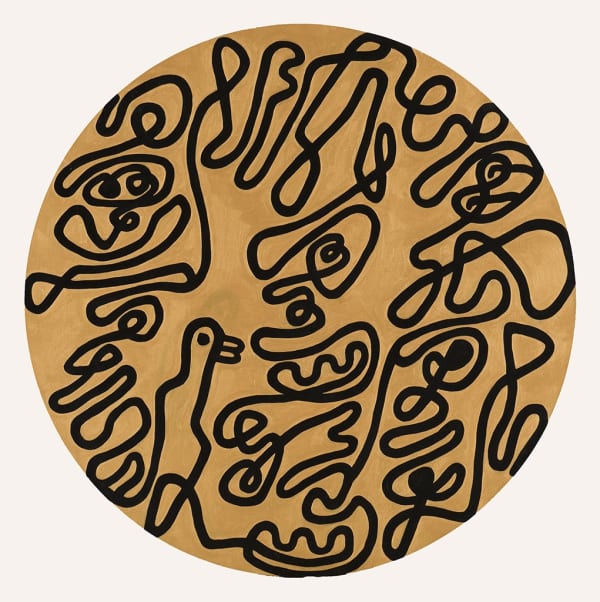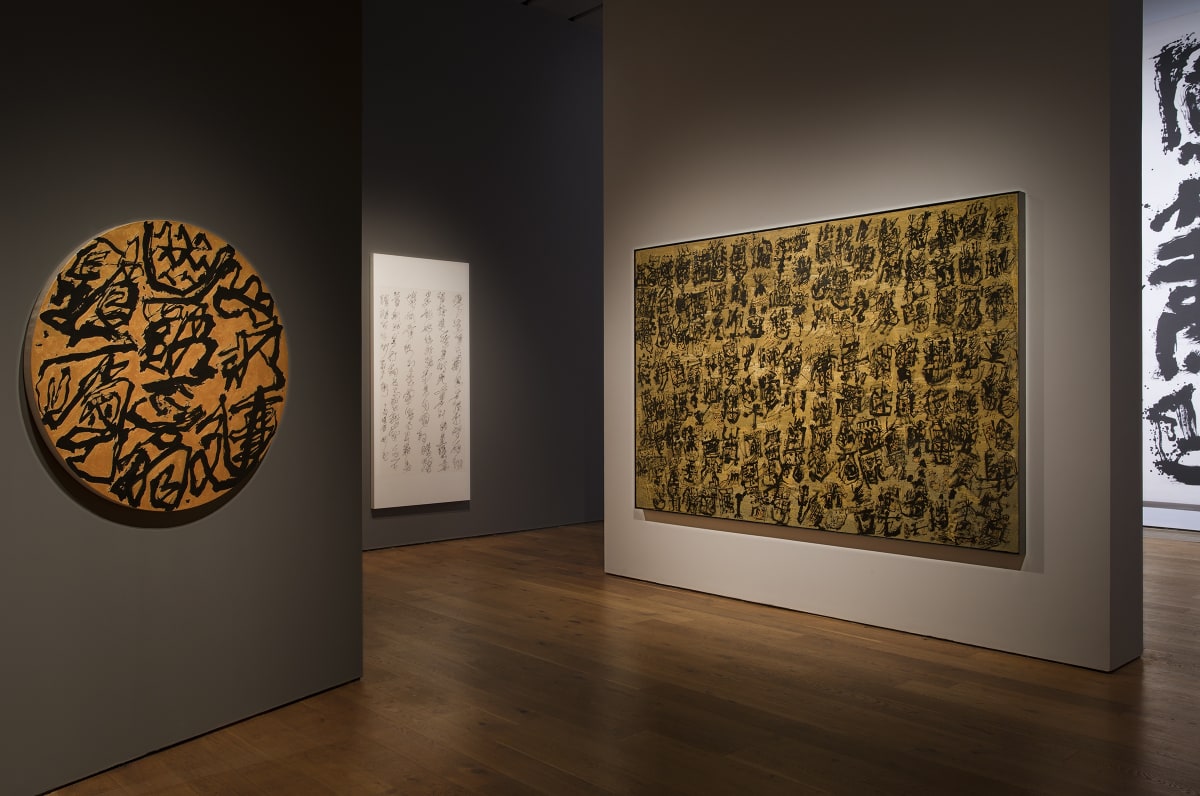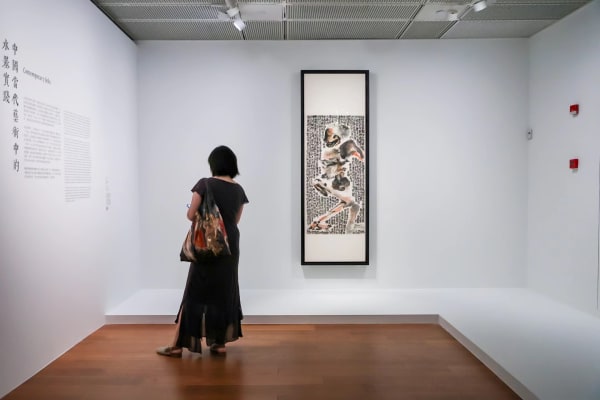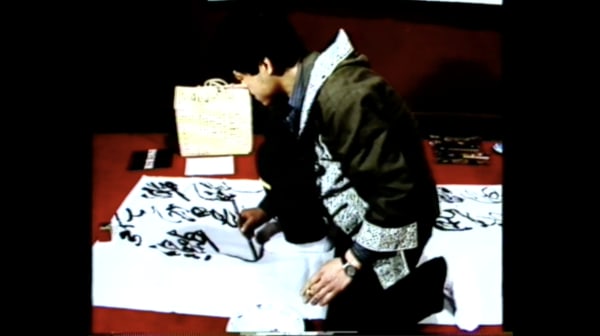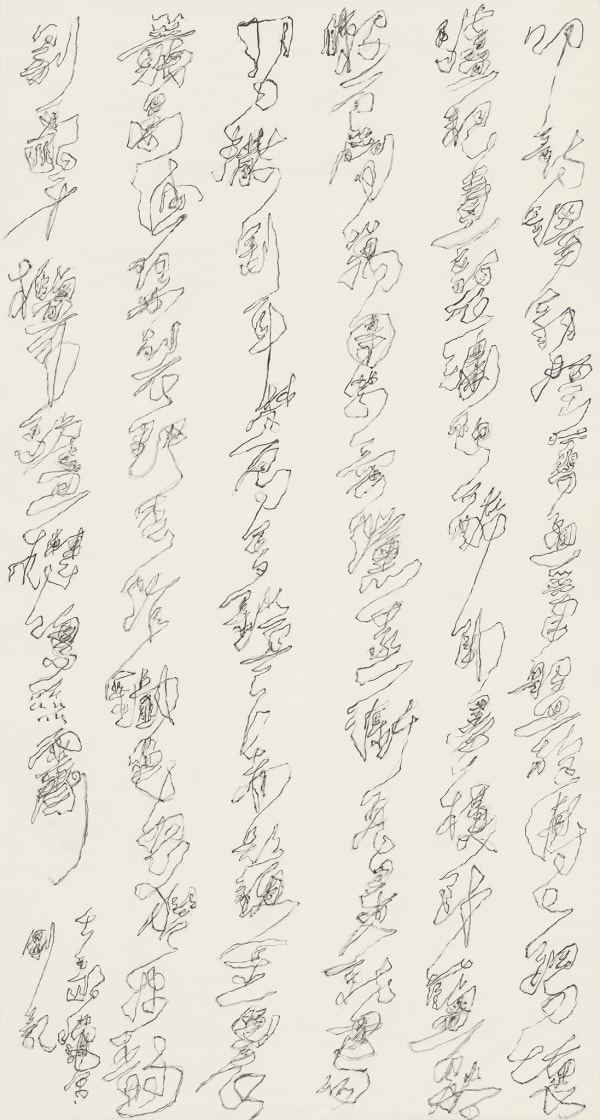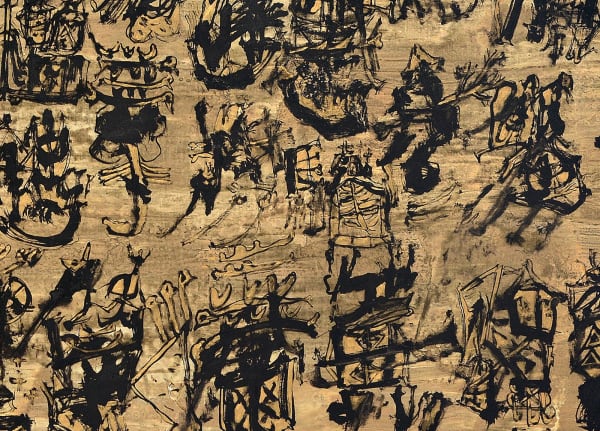In his career of three decades, Wei Ligang (b. 1964) has sought a universal language of abstraction based on the linear and spatial compositions of Chinese writing, a language capable of embodying the complexity and expansiveness of contemporary human knowledge and existence. His signature “magic squares,” which preserve the structure and strokes of Chinese characters and hark back to the pictographic origins of Chinese writing, are one of the earliest examples of a distinctly personal language in contemporary Chinese art. Wei Ligang generalizes the continuous cursive calligraphy of the 17th-century Shanxi calligrapher Fu Shan, applying it to the seal, clerical, and Oracle Bone scripts of antiquity to create the distinctive script styles of epigraphic mad cursive, “gold-ink cursive,” and “shadow cursive.” Wei Ligang is also the author of a celebrated body of calligraphy-informed abstract paintings.
Wei Ligang’s art is a unique fusion of systematic thought and sensibility, delicacy and spirituality, exoticism and naturalness. His wide-ranging inspirations include ancient Egyptian hieroglyphs, industrial civilization and modern machines, European castles and palaces, contemporary physics and astronomy, and the structures of animals and plants. He employs the bright colors of gold, red, and blue, and uses acrylic paints to increase substance and texture. In these respects his art differs from traditional Chinese calligraphy, which typically is monochrome and privileges fluency.
Wei Ligang was born in Datong, the first capital of the Northern Wei Dynasty (386-534) and home to the famous Buddhist grotto shrines of Yungang, which instilled in him a fondness for the grandeur of Han and Tang-dynasty art. Wei’s father, an art-loving railroad worker, inspired his interest in mechanics and calligraphy. At age 17, Wei entered the mathematics department of Nankai University, where he honed his logical and analytical skills. As President of the university calligraphy society, he came under the mentorship of the local masters Li Henian (1912-2000), Wang Xuezhong (1925-2013), and Sun Boxiang (1934-) in classical poetry and epigraphic scripts. Wang Xuezhong, an early pioneer of Modern Calligraphy, was especially influential to Wei.
After graduating from Nankai in 1985, Wei Ligang became a teacher at a normal school in Taiyuan and immersed himself in the legacy of Fu Shan, a fellow Shanxi native. In 1995, he relocated to the Old Summer Palace in Beijing as a professional artist, and thereafter increasingly engaged with abstract painting and international contemporary art. Over the 90’s, Wei gained prominence as a young pioneer of Modern Calligraphy, participating and organizing a number of influential exhibitions in the field, including Bashu Parade: A Review of China Modern Calligraphy At The End of 20th Century in 1999 in Chengdu. A committed educator and the founder of the International Shuxiang Society, he believes that Chinese calligraphy will reach an unprecedented height within this generation. He aims to develop “writing” (shuxie) into an art form capable of embodying all phenomena and things in the universe and a way to construct “pure structure itself.”
Wei Ligang was the recipient of the 2005 Asian Cultural Council Dr. Joseph K. W. Li Arts Fellowship. His works are in the collections of the Asian Art Museum, San Francisco; British Museum; Cernuschi Museum, Paris; Bill and Melinda Gates Foundation, Seattle; National Museum of China, Beijing; National Art Museum of China, Beijing; François-Henri Pinault Family, France; San Francisco Museum of Modern Art; among others.
-
 Blue Peacock 孔雀·蓝, 2012
Blue Peacock 孔雀·蓝, 2012 -
 Fluttering Butterflies and Buzzing Bees, A Pleasure Boat and Orchids at Dawn 蝶乱蜂喧 兰晓画舸, 2016
Fluttering Butterflies and Buzzing Bees, A Pleasure Boat and Orchids at Dawn 蝶乱蜂喧 兰晓画舸, 2016 -
 Ten Thousand Birds Startled by the Dawn Drums 万点城鸟惊曙鼓, 2011
Ten Thousand Birds Startled by the Dawn Drums 万点城鸟惊曙鼓, 2011 -
 A Thousand Iron-Clad Horses Crowding a Wild Field 千群铁马云屯野, 2016
A Thousand Iron-Clad Horses Crowding a Wild Field 千群铁马云屯野, 2016 -
 Shadow of a Qingdao Pine Tree 青岛的松影, 2010
Shadow of a Qingdao Pine Tree 青岛的松影, 2010 -
 Shadow Cursive 2 叠影草书(2), 2012
Shadow Cursive 2 叠影草书(2), 2012 -
 Shadow Cursive 1 叠影草书(1), 2012
Shadow Cursive 1 叠影草书(1), 2012 -
 West Lake Crab 西湖蟹, 2016
West Lake Crab 西湖蟹, 2016 -
 Song of the Phoenix Flute 凤箫曲, 2016
Song of the Phoenix Flute 凤箫曲, 2016 -
 Tangerine of Mount Dongting 洞庭橘, 2016
Tangerine of Mount Dongting 洞庭橘, 2016 -
 Quotations from Ouyang Xiu in Mad Cursive A 欧阳修辞抄狂草A, 2016
Quotations from Ouyang Xiu in Mad Cursive A 欧阳修辞抄狂草A, 2016 -
 Wei State of Myriad Beings 魏州万生园, 2016
Wei State of Myriad Beings 魏州万生园, 2016 -
 White Peacock 白孔雀, 2009
White Peacock 白孔雀, 2009 -
 Rhapsody on the Hall of Brightness 明堂赋, 2010
Rhapsody on the Hall of Brightness 明堂赋, 2010
-

Exhibition | Li Jin, Wang Tiande, Wei Ligang & Yang Jiechang at "Journey of Ink: Modern and Contemporary Chinese Painting from Musée Cernuschi"
October 9, 2024Journey of Ink: Modern and Contemporary Chinese Painting from Musée Cernuschi 6 Sep 2024 - 5 Jan 2025 Bund One Art Museum, Shanghai The Musée...Read more -

Wei Ligang | New Catalog Publication
March 23, 2022On March 5, 2022 (Saturday), artist Wei Ligang participated in a symposium held by the Zhi Art Museum at the UCCA Center for Contemporary Art...Read more



